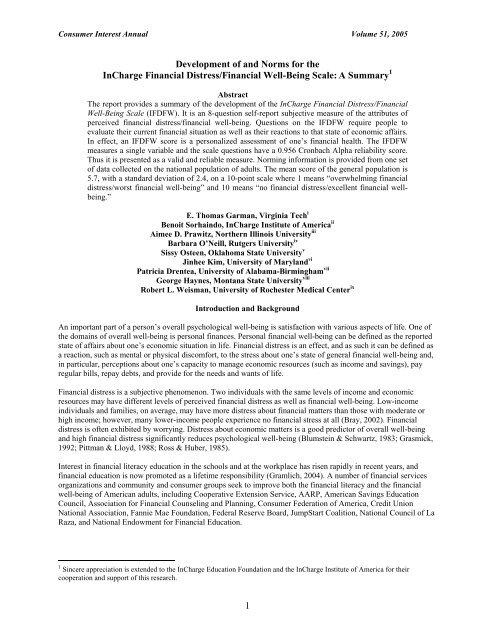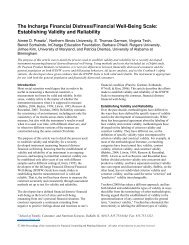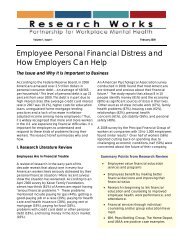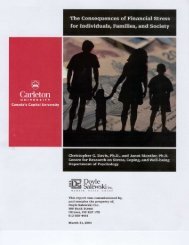to download this article (PDF). - Personal Finance Employee ...
to download this article (PDF). - Personal Finance Employee ...
to download this article (PDF). - Personal Finance Employee ...
Create successful ePaper yourself
Turn your PDF publications into a flip-book with our unique Google optimized e-Paper software.
Consumer Interest Annual Volume 51, 2005<br />
Development of and Norms for the<br />
InCharge Financial Distress/Financial Well-Being Scale: A Summary 1<br />
Abstract<br />
The report provides a summary of the development of the InCharge Financial Distress/Financial<br />
Well-Being Scale (IFDFW). It is an 8-question self-report subjective measure of the attributes of<br />
perceived financial distress/financial well-being. Questions on the IFDFW require people <strong>to</strong><br />
evaluate their current financial situation as well as their reactions <strong>to</strong> that state of economic affairs.<br />
In effect, an IFDFW score is a personalized assessment of one’s financial health. The IFDFW<br />
measures a single variable and the scale questions have a 0.956 Cronbach Alpha reliability score.<br />
Thus it is presented as a valid and reliable measure. Norming information is provided from one set<br />
of data collected on the national population of adults. The mean score of the general population is<br />
5.7, with a standard deviation of 2.4, on a 10-point scale where 1 means “overwhelming financial<br />
distress/worst financial well-being” and 10 means “no financial distress/excellent financial wellbeing.”<br />
E. Thomas Garman, Virginia Tech i<br />
Benoit Sorhaindo, InCharge Institute of America ii<br />
Aimee D. Prawitz, Northern Illinois University iii<br />
Barbara O’Neill, Rutgers University iv<br />
Sissy Osteen, Oklahoma State University v<br />
Jinhee Kim, University of Maryland vi<br />
Patricia Drentea, University of Alabama-Birmingham vii<br />
George Haynes, Montana State University viii<br />
Robert L. Weisman, University of Rochester Medical Center ix<br />
Introduction and Background<br />
An important part of a person’s overall psychological well-being is satisfaction with various aspects of life. One of<br />
the domains of overall well-being is personal finances. <strong>Personal</strong> financial well-being can be defined as the reported<br />
state of affairs about one’s economic situation in life. Financial distress is an effect, and as such it can be defined as<br />
a reaction, such as mental or physical discomfort, <strong>to</strong> the stress about one’s state of general financial well-being and,<br />
in particular, perceptions about one’s capacity <strong>to</strong> manage economic resources (such as income and savings), pay<br />
regular bills, repay debts, and provide for the needs and wants of life.<br />
Financial distress is a subjective phenomenon. Two individuals with the same levels of income and economic<br />
resources may have different levels of perceived financial distress as well as financial well-being. Low-income<br />
individuals and families, on average, may have more distress about financial matters than those with moderate or<br />
high income; however, many lower-income people experience no financial stress at all (Bray, 2002). Financial<br />
distress is often exhibited by worrying. Distress about economic matters is a good predic<strong>to</strong>r of overall well-being<br />
and high financial distress significantly reduces psychological well-being (Blumstein & Schwartz, 1983; Grasmick,<br />
1992; Pittman & Lloyd, 1988; Ross & Huber, 1985).<br />
Interest in financial literacy education in the schools and at the workplace has risen rapidly in recent years, and<br />
financial education is now promoted as a lifetime responsibility (Gramlich, 2004). A number of financial services<br />
organizations and community and consumer groups seek <strong>to</strong> improve both the financial literacy and the financial<br />
well-being of American adults, including Cooperative Extension Service, AARP, American Savings Education<br />
Council, Association for Financial Counseling and Planning, Consumer Federation of America, Credit Union<br />
National Association, Fannie Mae Foundation, Federal Reserve Board, JumpStart Coalition, National Council of La<br />
Raza, and National Endowment for Financial Education.<br />
1 Sincere appreciation is extended <strong>to</strong> the InCharge Education Foundation and the InCharge Institute of America for their<br />
cooperation and support of <strong>this</strong> research.<br />
1
Consumer Interest Annual Volume 51, 2005<br />
The objectives of financial education typically are <strong>to</strong> increase knowledge of basic financial concepts and improve<br />
people’s capacity <strong>to</strong> make personal finance decisions so they are more likely <strong>to</strong> be able <strong>to</strong> practice financial<br />
behaviors that will improve their short-term financial well-being and lead <strong>to</strong> overall long-term financial well-being.<br />
To accurately track behavioral changes and genuine financial success over time, researchers need a valid and<br />
reliable instrument <strong>to</strong> assess perceived financial distress and/or financial well-being.<br />
Purpose<br />
This study was undertaken <strong>to</strong> create the InCharge Institute Financial Distress/Financial Well-Being Scale (IFDFW),<br />
a self-report subjective measure of the attributes of perceived financial distress/financial well-being. This paper<br />
summarizes the development of the IFDFW and provides norming data for the general adult population and a<br />
population of financially distressed adults.<br />
His<strong>to</strong>ry of Scale Development<br />
The his<strong>to</strong>rical antecedents of the InCharge Financial Distress/Financial Well-Being Scale began more than<br />
forty years ago with various conceptual models of overall well-being and life satisfaction (Andrews & Withey,<br />
1976; Campbell, Converse & Rogers, 1976; Cantril, 1965; Davis, 1945; Festinger, 1957). A more recent model is<br />
the Quality of Life Inven<strong>to</strong>ry (QOLI) developed by Frisch, Cornell, Villanueva, and Retzlaff (1992); also see Frisch<br />
(1998).<br />
One of the domains of overall psychological well-being is financial situation, including economic distress;<br />
and personal finances is a good predic<strong>to</strong>r of lower levels of well-being (Blumstein & Schwartz, 1983; Grasmick,<br />
1992; Mirowsky & Ross; Pittman & Lloyd, 1988; Ross & Huber 1985). A variety of objective measures can be used<br />
<strong>to</strong> assess financial well-being, such as income, debt-<strong>to</strong>-income ratio, amount of savings, and net worth. However, it<br />
may take many months or even years <strong>to</strong> ascertain changes in one’s personal finances (such as improvements) with<br />
such broad measures.<br />
A number of researchers have measured financial well-being solely or primarily with subjective self-report<br />
measures (Bagwell, 2000; Bailey, 2003; Joo, 1998; Joo, 2002; Garman, Camp, Kim, Bagwell, Baffi, & Redican,<br />
1999; Grasmick, 1992; Kanjanapan, 2002; Kim, 1999; Kim, 2000; Porter, 1990; Shockey, & Seiling, 2004). Joo and<br />
Grable (2004) found that financial satisfaction is related, both directly and indirectly, with financial behaviors,<br />
financial stress levels, income, financial knowledge, financial solvency, risk <strong>to</strong>lerance, and education. These studies<br />
collectively confirm the notion that the domains of financial strain, financial distress and financial well-being<br />
constitute a multi-dimensional construct. Realizing that effective measures of perceived financial distress and<br />
overall financial well-being did not exist and would be useful, the InCharge Institute of America and the InCharge<br />
Education Foundation began an effort <strong>to</strong> develop a valid and reliable measure.<br />
Methodology<br />
A number of studies made of populations of adults who had typical distributions of financial well-being<br />
(Goodman, 2001; Joo, 1999; Kim, 1999; Kim, 2000) were examined as well as research on financially distressed<br />
individuals (Bagwell, 2000; Blumstein & Schwartz, 1983; Garman, Camp, Kim, Bagwell, Baffi, & Redican, 1999;<br />
Garman, Leech, & Grable, 1996; Grasmick, 1992; Joo, 1998; Joo & Garman, 1998; Mirowsky & Ross; Pittman &<br />
Lloyd, 1988; Ross & Huber 1985).<br />
The InCharge Education Foundation embarked on a series of studies, and data from six data collection<br />
efforts were analyzed during the progressive development of the InCharge Financial Distress/Financial Well-Being<br />
Scale. A six-item beta instrument was published in 2004 (Garman, Sorhaindo, Bailey, Kim, & Xiao, 2004; Garman,<br />
Sorhaindo, Kim, Xiao, Bailey, & Prawitz, 2004). The wording of some questions and anchor terms in the beta<br />
version differ in the final instrument. InCharge collected data in three national representative studies in 2004. One of<br />
these, the 2004 Mail Survey of the General Population, was used as the primary source of statistical analysis and<br />
norming, although other data sets were utilized for purposes of validity and reliability. This included a parallel<br />
survey of financially distressed adults.<br />
The 2004 Mail Survey of the General Population collected information about personal finances from a<br />
nationally representative sample of 1,300 responding adults in America. Almost all of the 51 questions on the survey<br />
instrument were used in previous research (Bagwell, 2000; Cantril, 1965; Kim & Garman, 2003; Kim, Sorhaindo, &<br />
Garman, 2003; O’Neill, Xiao, Sorhaindo, & Garman, in press; Porter, 1990; Porter & Garman, 1993; Sorhaindo &<br />
Garman, 2002; Sorhaindo, Kim, & Garman, 2003). The 51-item instrument contained 6 questions on current<br />
2
Consumer Interest Annual Volume 51, 2005<br />
financial situation, 6 questions on money management, 5 questions on bill paying behavior, 3 on tight financial<br />
situation, 5 questions on family life and health, 8 questions on work, 8 on retirement, and 10 questions on<br />
demographics. Twenty-seven of those questions dealt with various aspects of financial distress and financial wellbeing,<br />
and each was examined with an eye <strong>to</strong>ward including it in the final IFDFW scale.<br />
Results<br />
The IFDFW is based upon the personal finance concepts, findings and methodologies employed in 30<br />
conceptual frameworks and related academic studies, 11 general population surveys conducted by others,<br />
suggestions from 50 personal finance experts in academia and 40 experts in business, and six data collections<br />
conducted by InCharge. These efforts led <strong>to</strong> identification of 58 descriptive personal finance concepts that were<br />
narrowed <strong>to</strong> 20 utilizing three qualifying criteria.<br />
A three-phase modified Delphi study of a national panel of 45 personal finance experts ranked the<br />
suitability of each concept for inclusion in a financial well-being scale. Ten concepts gained consensus from the<br />
experts with two ranked unanimously as the number one and two highest in all three data collections and the other<br />
eight concepts were ranked in the <strong>to</strong>p 10 in all three phases.<br />
Each concept was then re-examined in the context of scaling and anchor terms that had been utilized in<br />
previous research and two other parallel data collections. Sometimes a concept and/or question can be made much<br />
clearer <strong>to</strong> a subject when it is accompanied by descriptive anchor terms. For example, the anchor term<br />
“overwhelming stress” gives more meaning <strong>to</strong> a stem question asking: What do you feel is your financial stress<br />
<strong>to</strong>day? After data from the general population study were collected, a 12-item set of validity and reliability criteria<br />
was applied <strong>to</strong> all potential concepts, including those ranked by the Delphi experts, in order <strong>to</strong> be considered for the<br />
final scale.<br />
The result was that the three concepts ranked the lowest by the experts were deleted for two reasons: (1)<br />
their mean scores were significantly distant from the higher seven rankings, and (2) each was redundant with other<br />
concepts (Garman, Sorhaindo, Prawitz, Osteen, Kim, O’Neill, Drentea, Haynes, & Weisman, 2005). The other 27<br />
personal finance concept/questions in the survey instrument were re-reviewed as potential contribu<strong>to</strong>rs <strong>to</strong> the scale.<br />
An additional concept was selected for its statistical strength and content validity.<br />
The final scale is made up of eight questions. The questions on the InCharge Financial Distress/Financial<br />
Well-Being Scale ©2 (IFDFW) are presented below. As they appear here they are without value and will collect<br />
incorrect data without the accompanying appropriate directions, specific fonts, scaling, spacing, anchor terms and<br />
placement, and sequencing. At <strong>this</strong> time, permission is required <strong>to</strong> use the scale questions. The questions are:<br />
1. What do you feel is the level of your financial stress <strong>to</strong>day?<br />
2. On the stair steps below, mark (with a circle) how satisfied you are with your present financial<br />
situation. The “1” at the bot<strong>to</strong>m of the star steps represents complete dissatisfaction. The “10” at the<br />
<strong>to</strong>p of the stair steps represents complete satisfaction. The more dissatisfied you are, the lower the<br />
number you should circle. The more satisfied you are, the higher the number you should circle.<br />
3. How do you feel about your current financial condition?<br />
4. How often do you worry about being able <strong>to</strong> meet normal monthly living expenses?<br />
5. How confident are you that you could find the money <strong>to</strong> pay for a financial emergency that costs<br />
about $1,000?<br />
6. How often does <strong>this</strong> happen <strong>to</strong> you? You want <strong>to</strong> go out <strong>to</strong> eat, go <strong>to</strong> a movie or do something else<br />
and don’t go because you can’t afford <strong>to</strong>?<br />
7. How frequently do you find yourself just getting by financially and living paycheck <strong>to</strong> paycheck?<br />
8. How stressed do you feel about your personal finances in general?<br />
The general population dataset was used in establishing initial norms. The mean score of the general<br />
population of adults is 5.7, with a standard deviation of 2.4, on a 10-point scale where 1 means<br />
“overwhelming financial distress/worst financial well-being” and 10 means “no financial distress/excellent<br />
financial well-being.” Thirty-percent rated themselves with low scores between 1 and 4, 29 percent marked<br />
the mid-points of 5 or 6, and 42 percent reported themselves with high scores between 7 and 10 (numbers<br />
do not add <strong>to</strong> 100 because of rounding). Regarding employment status, the mean norms are: employed, 5.7;<br />
unemployed, not seeking work, 4.9; unemployed, but seeking work, 3.4; and retired, 6.4. The gender mean<br />
2 ©Copyright by InCharge Education Foundation (http://www.inchargefoundation.org/) and E. Thomas Garman,<br />
LLC (http://www.EthomasGarman.net), 2005. All rights reserved.<br />
3
Consumer Interest Annual Volume 51, 2005<br />
scores are males, 6.2 and females 5.4. The mean scores for marital status are married, living with partner,<br />
6.2; single, never married, 5.1; widowed, 6.1; and divorced, 4.8.<br />
Conclusion<br />
A <strong>to</strong>tal of 1,097 cases in the general population study were analyzed. Fac<strong>to</strong>r analysis statistics show that the<br />
InCharge Financial Distress/Financial Well-Being Scale (IFDFW) measures a single fac<strong>to</strong>r, and the Cronbach<br />
Alpha for the eight questions on the IFDFW is a very robust 0.956. An acceptable Cronbach Alpha can be as low as<br />
0.60 (Nunnally & Bernstein, 1994). When decisions are going <strong>to</strong> be made on the scores made by individuals, rather<br />
than groups, the measurement error must be extremely low, and “a reliability of .90 is the ‘bare minimum,’ and a<br />
reliability of .95 should be considered the desirable standard (Nunnally & Bernstein, 1994, p. 265).” The IFDFW<br />
combines the results of eight individual questions that efficiently, validly and reliably measure the domain or<br />
construct of financial distress/financial well-being.<br />
References Cited<br />
Andrews, F. M., & Withey, S. B. (1976). Social indica<strong>to</strong>rs of well-being: Americans’ perceptions of life quality.<br />
New York: Plenum Press.<br />
Bagwell, D. C. (2000). Work and <strong>Personal</strong> Financial Outcomes of Credit Counseling Clients. Unpublished<br />
doc<strong>to</strong>ral dissertation, Virginia Polytechnic Institute and State University, Blacksburg.<br />
Bailey, W. C. (2003). A pilot study of financial distress and behavior changes among debt management program<br />
clients. Unpublished paper. University of Arkansas.<br />
Bray, R. (2002). Hardship in Australia: An analysis of financial stress indica<strong>to</strong>rs in the 1998-99 Australian<br />
Bureau of Statistics Household Expenditure Survey, Occasional Paper No. 4, Department of Family and Community<br />
Services, Canberra, Australia.<br />
Blumstein, P. W., & Schwartz, P. (1983). American Couples: Money, Work, Sex. New York: William Morrow.<br />
Campbell, A., Converse, P. E., & Rodgers, W. L. (1976). The Quality of American Life: Perceptions,<br />
Evaluations, and Satisfactions. New York: Russell Sage Foundation.<br />
Cantril, H. (1965). The Pattern of Human Concerns. New Brunswick, NJ: Rutgers University Press.<br />
Davis, J. S. (1945). Standards and content of living. The American Economic Review, 35, 1-11.<br />
Festiger, L. (1957). A theory of cognitive dissonance. Stanford: Stanford University Press.<br />
Frisch, M. B., (1998). Quality of life therapy and assessment in health care. Clinical Psychology: Science and<br />
Practice, (5)1, 19-40.<br />
Frisch, M. B., Cornell, J., Villanueva, M., & Retzlaff, P. J. (1992). Clinical validation of the quality of life<br />
inven<strong>to</strong>ry: A measure of life satisfaction for use in treatment planning and outcome assessment. Psychological<br />
Garman, E. T., Camp, P., Kim, J., Bagwell, D., Baffi, C., & Redican, C. (1999). Credit delinquencies: A portrait<br />
of pain for employers’ bot<strong>to</strong>m lines—Preliminary findings. <strong>Personal</strong> <strong>Finance</strong>s and Worker Productivity, 3(1), 165-<br />
168. Virginia Polytechnic Institute and State University, Blacksburg. Retrieved on February 11, 2004, from the<br />
website: wwwEthomasGarman.net.<br />
Garman, E. T., Leech, I. E., & Grable, J. E. (1996). The negative impact of employee poor personal financial<br />
behaviors on employers. Financial Counseling and Planning, 7, 157-168.<br />
Garman, E. T., Sorhaindo, B., Bailey, W., Kim, J., & Xiao, J. (2004). Financially distressed credit counseling<br />
clients and the InCharge Financial Distress/Financial Well-Being Scale. In J. Fox (Ed.) Proceedings of the Eastern<br />
Regional Family Economics and Resource Management Association 2004 Conference (pp. 71-81).<br />
Garman, E. T., Sorhaindo, B., Kim, J., Xiao, J. J., Bailey, W., & Prawitz, A. D. (2004) The development of the<br />
beta version of the InCharge Financial Distress Scale. Consumer Interests Annual (50), 134-144.<br />
Garman, E. T., Sorhaindo, B., Prawitz, A. D., Osteen, S., Kim, J., O’Neill, B. Drentea, P., Haynes, G., &<br />
Weisman, R. L. (2005, unpublished manuscript). The development, validation, reliability and national norms of the<br />
InCharge Financial Distress/Financial Well-Being Scale: A subjective measure for use in benchmarking and<br />
outcome assessment.<br />
Gramlich, E. M. (2004, May 20). Workplace financial education: Remarks by Governor Edward M. Gramlich.<br />
Speech <strong>to</strong> the second meeting of the Financial Literacy and Education Commission, Washing<strong>to</strong>n, DC.<br />
Grasmick, R. J. (1992). The effects of gender, family satisfaction, and economic strain on psychological wellbeing.<br />
Family Relations, 41, 440-446.<br />
Joo, S. (1998). <strong>Personal</strong> Financial Wellness and Worker Productivity. Unpublished doc<strong>to</strong>ral dissertation,<br />
Virginia Polytechnic Institute and State University, Blacksburg, VA.<br />
4
Consumer Interest Annual Volume 51, 2005<br />
Joo, S. (2002). Workplace financial education: If you provide it who will come? Journal of <strong>Personal</strong> <strong>Finance</strong><br />
(1:1; 45-57.<br />
Joo, S., & Garman, E. T. (1998, November). The relationship between personal financial wellness and employee<br />
productivity: A conceptual model. <strong>Personal</strong> <strong>Finance</strong>s and Worker Productivity (2), 2. 162-171.<br />
Joo, S., & Grable, J. E. (2004, Spring). An explora<strong>to</strong>ry framework of the determinants of financial satisfaction.<br />
Journal of Family ande Economic Issues (25), 1, 25-50.<br />
Kanjanapan, W. (2002, September/Oc<strong>to</strong>ber). Labour fource patterns and self-perceived health status among<br />
older Australians. Commonwealth Department of Health and Ageing. Paper presented at the Australian Public<br />
Health Association Conference in Adelaide. Retried at http://www.melbourneinstitute.com/hilda/health-w1.pdf.<br />
Kim, J. (1999). Financial satisfaction, personal finance-work conflict, and work outcomes: Pay satisfaction,<br />
organizational commitment, and productivity, Proceedings of the Association for Financial Counseling and Planning<br />
Education Annual Conference, Scottsdale, AZ, 38-45.<br />
Kim, J. (2000). The Effects of Workplace Financial Education on <strong>Personal</strong> <strong>Finance</strong>s and Work Outcomes.<br />
Unpublished doc<strong>to</strong>ral dissertation, Virginia Polytechnic Institute and State University, Blacksburg, VA.<br />
Kim, J., Bagwell, D., Garman, E. T., & Goodman, J. (1998). <strong>Personal</strong> <strong>Finance</strong>s and Worker Productivity, 2(2),<br />
150-152. Virginia Polytechnic Institute and State University, Blacksburg.<br />
Kim, J., & Garman, E. T. (2003). Financial stress and absenteeism: An empirically derived model, Financial<br />
Counseling and Planning (14;1), 31-42.<br />
Kim, J., Sorhaindo, B., & Garman, E. T. (2003). Relationship between credit counseling, financial well-being<br />
and health. Consumer Interest Annual, Vol. 49. Retrieved February 11, 2004, from the website<br />
www.EthomasGarman.net.<br />
Mirowsky, J. & Ross, C. (2003). Social Causes of Psychologyical Distress. 2 nd Edition. Aldine de Gruyter:, NY.<br />
Nunnally, J. C., & Bernstein, I. H. (1994). Psychometric Theory (third edition). New York: McGraw Hill.<br />
O’Neill, B., Xiao, J. J., Sorhaindo, B., & Garman, E. T. (in press). Relationships among financial practices,<br />
financial well-being, and health of financially distressed consumers. Consumer Interests Annual.<br />
Pittman, J. F., & Lloyd, S. A. (1988). Quality of family life, social support, and stress. Journal of Marriage and<br />
the Family, 50, 53-67.<br />
Porter, N. M. (1993). Testing a Conceptual Model of Financial Well-being. Unpublished doc<strong>to</strong>ral dissertation,<br />
Virginia Polytechnic Institute and State University, Blacksburg, VA.<br />
Porter, N. M., & Garman, E. T. (1993). Testing a conceptual model of financial well-being. Financial<br />
Counseling and Planning, 4, 135-164.<br />
Ross, C & Huber, J. (1985). Hardship and depression. Journal of Health and Social Behavior, 26, 312-27.<br />
Shockey, S. S., & Seling, S. B. (2004). Moving in<strong>to</strong> action: Application of the transtheoretical model of<br />
behavior change <strong>to</strong> financial education, Financial Counseling and Planning (15:1), 41-52.<br />
Sorhaindo, B. & Garman, E. T. (2002, May 2). InCharge Debt Solutions 18-month panel study: Changes in<br />
financial behavior and incidence of financial stressors. Retrieved February 11, 2004, from the InCharge Institute of<br />
America website: http://www.education.incharge.org/media/WPS012.pdf.<br />
Sorhaindo, B., Kim, J., & Garman, E. T. (2003). Credit counseling succeeds: The effects of credit counseling on<br />
financial stressors, behaviors and well-being. Proceedings of the Association for Financial Counseling and Planning<br />
Education.<br />
i Advisor and Author, Fellow and Professor Emeritus, Virginia Tech University, 8044 Rural Retreat Court, Orlando,<br />
FL 32819, USA, tel. 407-363-9048, www.EthomasGarman.net, tgarman@bellsouth.net.<br />
ii Direc<strong>to</strong>r of Research, InCharge Education Foundation, 2101 Park Center Drive, Suite 310, Orlando, FL 32835,<br />
USA, tel. 407-532-5704, fax. 407-532-5750, www.education.incharge.org, bsorhain@incharge.org.<br />
iii Associate Professor, Northern Illinois University, School of Family, Consumer, and Nutrition Sciences, DeKalb,<br />
IL 60115, USA, tel. 815-753-6344, fax. 815-753-1321,aprawitz@niu.edu<br />
iv Professor, Specialist in Financial Resource Management, Rutgers Cooperative Extension, Rutgers University,<br />
Cook College Building, Room 107, 55 Dudley Road, New Brunswick, NJ 08901, USA, Phone 732-932-9155, X250,<br />
Email oneill@aesop.Rutgers.edu.<br />
v Assistant Professor Resource Management and Extension Specialist, Oklahoma State University, 333 HES,<br />
Stillwater, OK 74078, USA, tel. 405-744-6282, fax. 405-744-1461, sissyosteen@okstate.edu. 405-744-6282.<br />
5
Consumer Interest Annual Volume 51, 2005<br />
vi Assistant Professor and Extension Specialist, University of Maryland, Department of Family Studies, 1204 Marie<br />
Mount Hall, College Park, MD 20742-7515, USA, tel. 301-405-3500, fax. 301-314-1961, jinkim@umd.edu.<br />
vii Associate Professor, University of Alabama-Birmingham, Department of Sociology, 237 Ullman Building, 1530<br />
South 3 rd Avenue South, Birmingham, AL 35297-3350, USA, tel. 205-934-2562, pdrentea@uab.edu.<br />
viii Associate Professor Consumer Science, Montana State University, 205B Herrick Hall, Bozeman, MT 59717-<br />
3540, USA, tel. 406-994-5012, haynes@montana.edu.<br />
ix Assistant Professor, University of Rochester Medical Center, Department of Psychiatry, School of Medicine and<br />
Dentistry, Direc<strong>to</strong>r of Projects Link and ACT at the Strong Ties Community Support Program, 1650 Elmwood<br />
Avenue, Rochester, NY 14620, USA, tel. 585-275-0300, x-2258, Robert_Weisman@urmc.rochester.edu.<br />
6









